
When our cubby first arrived a number of years ago, it was a big hit. Meals on the verandah were frequent. Two years later a make-over is required.
Operation cubbyhouse make-over is finished!! Many friends and families I know complain that their cubby house is a white elephant. While our cubby is one of the first things in use when visitors come around, it has not been well-used by our own children recently. Like all things, the novelty has worn off and it is time for a “home improvement” project. (Particularly as the wet weather has arrived and it gives the children something to do outside even when it is raining.)
The following ideas will help make our cubby (and yours) an attractive play option this winter. Don’t forget to change the contents occasionally and limit what is available at once. Everything out together will make for one huge mess and actually works against producing worthwhile play.
Choose open-ended accessories and toys that promote imagination. How do you know if something is open-ended? Ask yourself what you can do with it. A toy vacuum cleaner can pretty much be used for vacuuming and that’s it, making it a closed toy choice. A pile of sheets can be princess gowns, bedding, room dividers and so on, therefore it is an open-ended play choice.
RECOMMENDED PLAY HOUSE ACCESSORIES:
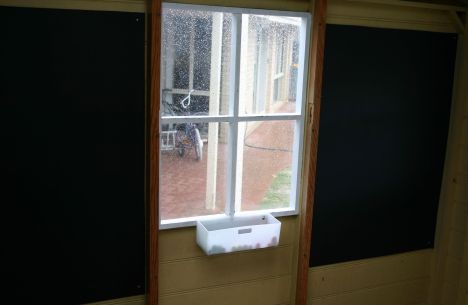
Blackboard and chalk. Buy some blackboard paint and make one whole wall a drawing space. Not a little square mind you – a whole wall. Either paint onto wood and mount across the wall or paint the cubby wall itself if it has a fairly flat wood surface. Screw up a bucket of coloured chalk and a duster and watch the many different ways it will be used. We find that a damp cloth often works better than an actual duster to remove the chalk. I also hung up two smaller blackboards that can be taken down to serve as menu boards and order tablets etc.
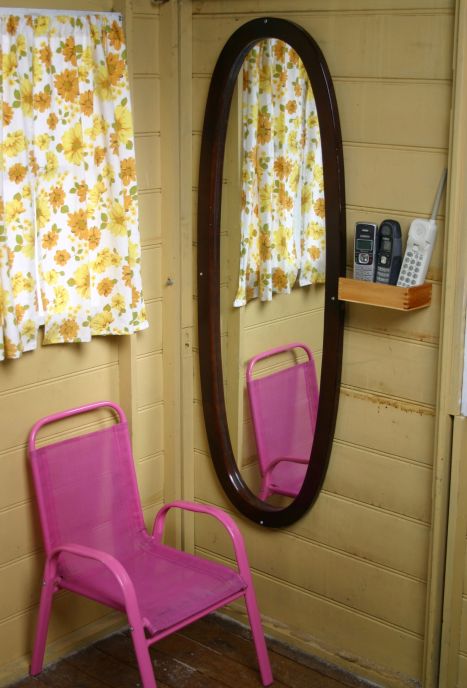
Telephone. My Mum loves to tell us about the working field telephone they had when she was young, strung up between the cubby and their house for real two-way conversations. Unfortunately we don’t have this option but a pretend phone is a must. You could add some phone books to look up numbers. I came across a telephone station idea on the web that had a large mirror behind it. I have never considered a mirror being linked to phone play but apparently children enjoy watching themselves talk on the phone and it is great for language development. It seems to be true because the moment the mirror was up my son grabbed a phone from elsewhere (I hadn’t screwed them on the wall yet), pulled up a chair and sat down to watch himself chatting to imaginary family members.
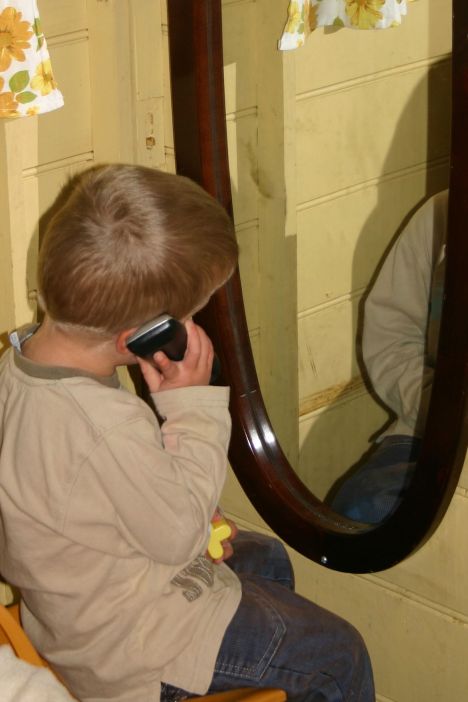
Door bell. Well mannered cubby visitors must learn to knock or ring right? Toddlers and young children will love ringing the bell every time they go in and out.
Letterbox. Add some paper, envelopes, drawing equipment, stickers for stamps and a sack to collect and deliver the mail with. Really cool letter boxes are the ones with a little flag to put up to let the children know the mailman has been. If Mum or Dad occasionally stick in a letter the excitement will be huge. Perhaps an invitation to afternoon tea?
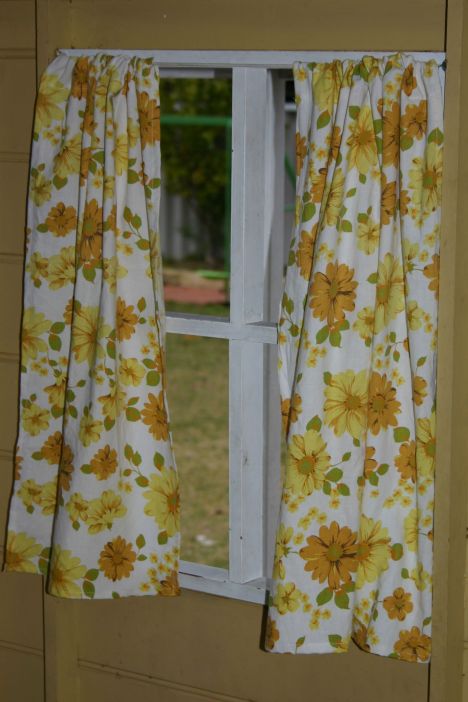
Curtains. I asked all the children what they would like to have added to the cubby. There were several usable ideas (pictures, letter box and curtains) and other not-so practical ideas (roller shutters, water piped from the gutters to a real tap, a real oven and a working light – there are no electricity points in our backyard.) I happily agreed to the curtain idea and sewed some up from an old sheet. A quick hem around each side and double over the end to thread the hanging wire through – about the limit of my sewing skills!

Table and chairs. No cubby is complete without a child-sized table and chairs. Activities like the letter writing can be set up on it or use it for the more traditional restaurant, cafe and home kitchen play. There was enough sheet left to make a table-cloth to match the curtains.
Pretend cooking equipment. Items such as plates, cups, cutlery, tablecloth, napkins, pots, pans, muffin tins, cake tins, wooden spoons, whisks, egg flips, cutting boards etc. Children love to use real items so use old stuff from your own kitchen or visit the local recycled store for some cheap kitchen gear. While I prefer natural materials such as wood and metal, the reality is that outside these dishes will be covered in sand and water in no time, so I have re-homed some of the many plastic sets people give the children for Christmas and kept my nice natural equipment for pretend play indoors where it will survive for much longer.
Small bookcase, kitchenette or shelves. Set them at child’s height and use them to store the cooking equipment. Add some cup hooks and pegs to hang up the pans and what-not.

Stove or oven. Even a box turned on its side will do at a pinch. A kid needs somewhere to bake his pies! I have kept ours out on the verandah for extra space and sandy baking projects as the older girls have been complaining that the sand messes up the cubby after they have swept it! Hmmm sounds a lot like my house….
Rocks, pebbles, glass jewels (the kind you add to vases), pieces of natural wood and other such items have unending possibilities for food based play. Avoid plastic pretend food items as these limit play. A plastic pizza is a plastic pizza. An attractive river stone can be a freshly baked bun, biscuit, muffin, piece of meat etc.
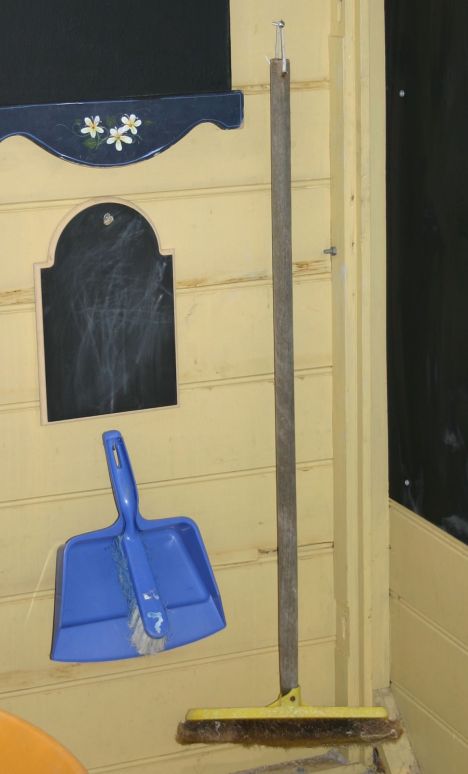
Child-sized broom. Cut the handle off a regular indoor broom to make it child-sized and hang up a dustpan and brush. You will be surprised at how many times the children choose to sweep out their house.

 Old sheets, cushions and some kind of bed. We picked up an old cot mattress and a large couch cushion during verge collection in our area that make great bed bases, along with the small decorative cushions for pillows. They are not too big or heavy and can be stored standing up against the cubby wall when not in use. More importantly, there are enough for several children to be “sleeping” at once; very important during hospital play. There is also a very large old-fashioned bassinet that fits the small children very well.
Old sheets, cushions and some kind of bed. We picked up an old cot mattress and a large couch cushion during verge collection in our area that make great bed bases, along with the small decorative cushions for pillows. They are not too big or heavy and can be stored standing up against the cubby wall when not in use. More importantly, there are enough for several children to be “sleeping” at once; very important during hospital play. There is also a very large old-fashioned bassinet that fits the small children very well.
Dress-ups and a mirror. I don’t leave my dress-ups outside, but occasionally pop them into the cubby. Dressing up is enjoyed by all but if the children can see themselves in a mirror, the fun triples. While a couple of princess gowns are nice, a pile of old sheets, scarves, hats, shoes, fabric pieces and other accessories allow children so many more play options. Again, a princess dress will usually be used as a princess dress. A fabulous piece of cloth has endless options.
Themed pretend-play accessories. Set up a few extras for a doctor’s surgery, shop, restaurant, beauty parlour, pet store or more. See this post for heaps of theme ideas.
Water table. (Picture of ours here.) During cool weather, this can be filled with sand or rice or wheat or anything really. Add a few accessories and watch the play develop. Sensory tubs as they are often known are great for rainy days. See this post for lots of indoor ideas, or my toddler activities Pinterest page for heaps more. Some of them (the messy ones) lend themselves to outdoor play more than others.
SIX CUBBY HOUSE MISTAKES TO AVOID:
1.Using it as a store-all for all the outdoor toys. You can’t play in a junk pile people!
2. Leaving it empty. A box on legs is still just an empty box and unlike giant cardboard boxes which have endless uses, an empty cubby is just not that much fun.
3. Putting it too far away from the action. Children occasionally like to hide away but as a general rule, they will be far more likely to consistently use a play house if it is located centrally to the rest of your outdoor area or close to the house. Joined on to a sandpit for example is excellent as the sand then becomes part of the play and opens a whole new dimension of pretend play ideas. Mud pies in the cubby oven are good for hours of entertainment.
4. Small, high windows. For much the same reason as above; children like to be able to pop in and shut a curtain etc. to feel like they have a little privacy but most of the time want to be able to see what is going on and not feel too shut in. Having a good, low window at the front to play shops, serve food through etc. is ideal.
5. Getting hung up about keeping the cubby tidy. It’s not your house or the kid’s bedroom! Let them make some mess. Let them bring in sandpit sand, pebbles from the driveway, leaves or whatever else is making for great pretend play that day. That’s why you include a broom and dustpan!
6. Buying a cubby that is too small. It’s handy if an adult can stand inside but not necessary of course. Think ahead though – if 2 little children fit well, what about when they grow or more children are welcomed to the family? Or when visitors arrive? If you are going to have a well-used cubby, there needs to be space for the mini kitchen, the bed, the blackboard and all the other great accessories that make or break a play house. Too small and you will be very limited in what you can do.
While I haven’t added every idea to our cubby as yet, I am done for now. When interest wanes and something new is required, I’ll get back to the doorbell, letterbox and other items.
What great ideas do you have to make your cubbyhouse a great place to play?
Filed under: Outdoors, Rainy day activities | Tagged: cubby house, cubbyhouse, decor, decorating, design, home corner, imagination, interior, Montessori for preschoolers, outdoor play ideas, play house, pretend play, rainy day activities | Leave a comment »




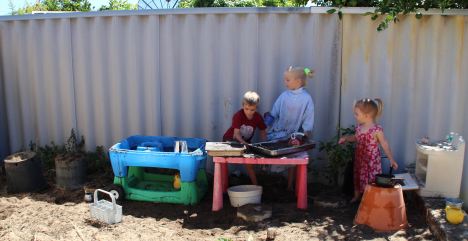
 Everything we set out we have had for a long time. Simply moving it all to a new location and adding dirt and water resulted in a whole new activity which was received with great excitement. The plastic oven above hasn’t been touched for months but was immediately put to use. 10 minutes to set up, a zero dollar outlay and the mud kitchen was ready for action.
Everything we set out we have had for a long time. Simply moving it all to a new location and adding dirt and water resulted in a whole new activity which was received with great excitement. The plastic oven above hasn’t been touched for months but was immediately put to use. 10 minutes to set up, a zero dollar outlay and the mud kitchen was ready for action. It would have been a good idea to get all the children to put on painting shirts (Dad’s old work shirts) before they had at it but I naively thought they wouldn’t get quite so dirty as they did! Much fun was had and some (mostly) harmonious play was a nice change to the recent conflict we have been experiencing.
It would have been a good idea to get all the children to put on painting shirts (Dad’s old work shirts) before they had at it but I naively thought they wouldn’t get quite so dirty as they did! Much fun was had and some (mostly) harmonious play was a nice change to the recent conflict we have been experiencing.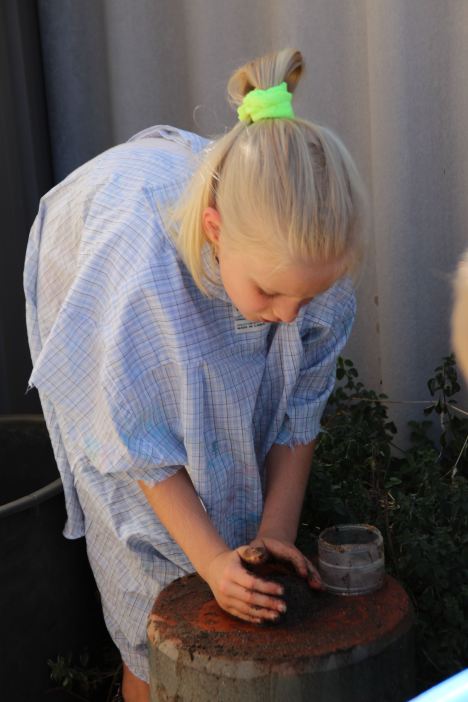









 Old sheets, cushions and some kind of bed. We picked up an old cot mattress and a large couch cushion during verge collection in our area that make great bed bases, along with the small decorative cushions for pillows. They are not too big or heavy and can be stored standing up against the cubby wall when not in use. More importantly, there are enough for several children to be “sleeping” at once; very important during hospital play. There is also a very large old-fashioned bassinet that fits the small children very well.
Old sheets, cushions and some kind of bed. We picked up an old cot mattress and a large couch cushion during verge collection in our area that make great bed bases, along with the small decorative cushions for pillows. They are not too big or heavy and can be stored standing up against the cubby wall when not in use. More importantly, there are enough for several children to be “sleeping” at once; very important during hospital play. There is also a very large old-fashioned bassinet that fits the small children very well.
















